Heeba Shehadah | Ammar Ziadeh
Drawing on governmental figures, UN estimates, and the opinions of experts and analysts, Enab Baladi attempts in this file to identify the reasons behind the ignition of fires in the forests and the parties benefiting from this as well as their impact on Syria at present and in the future.
Abdel Moein al-Masri, head of the local council in Qabr Fiddah, lost his house after his village, located a few kilometers away from the mountains of Latakia, had fallen into the hands of the Syrian regime forces in 2015. However, he did not lose his memory about the acts of the Syrian regime thereof.
The forty-year-old man has relived the events happening over the past decades, to find himself saying that the season of “setting” the forests on fire was routine in the region and that the reasons behind as well as the alleged perpetrators are known to everybody, as the outbreak of fires usually coincides with the approach of winter for the sake of logging and the exploitation of the burned lands, taking place “with the knowledge of the state.”
According to data released by the Syrian government’s Ministry of Agriculture and Agrarian Reform, 57 forest fires broke out, leading to the destruction of 1.7 hectares of protected lands from the beginning of this year until 9 September.
The Ministry of Interior announced on 11 September that six suspects were arrested following the fire incident. It was found out later that “they had started fires in their agricultural lands, which later spread to the adjacent forests.”
Al-Masri believes that the fires did not break out naturally but were somewhat contrived. The locals exploit such fires for farming, logging, and charcoal trading activities, which the State declares permissible once the fires are put out. However, the authorities “deny the residents of neighboring areas access to that,” the head of the local council told Enab Baladi.

The Syrian Civil Defense volunteers extinguishing the fires spreading from the south to Jisr al-Shughur in the western countryside of Idlib– 11 September 2020 (Syria Civil Defense – Idlib Governorate Facebook)
What kind of forests does Syria have?
Forests used to cover most of the Syrian territory in ancient times, as evidenced by historical monuments. However, this green area has receded over the centuries until “the government realized the importance of forests and trees, and declared the last Thursday of every year the “Arbor Day,” according to a report presented by the Forestry Directorate at the Ministry of Agriculture and Agrarian Reform to the Food and Agriculture Organization of the United Nations (FAO) in 1993.
The first celebration of Arbor Day was in 1952. In 1960, reforestation projects became part of the government’s five-year plans, and a particular budget was allocated for this purpose because forests are of great economic significance for the provision of industrial wood, raw materials (for the production of paper and wooden boxes), charcoal and other materials for the local market.
The report divided the forest area, amounting to 445,000 hectares, into 150,000 hectares of pine, cedar, fir, and oaks in Tartus, Latakia, Idlib, and Hama, and 225,000 hectares of sporadic forests “suitable only for manufacturing charcoal” in Damascus, Homs, Aleppo and As-Suwayda, and 70,000 hectares of mostly pistachios and juniper, in Hama and Damascus.
The efforts to expand the forest area began by the forestation of 8,000 hectares between 1952 and 1976 and planting more than 25 million trees between 1977 and 1984 annually. Additionally, more than 96,000 hectares were recovered for the same purpose, which increased the number of planted trees to 30 million per year.
Hassan Fares, Director General of Forestry at the Ministry of Agriculture and Agrarian Reform, stated that the Ministry could not keep pace with the afforestation projects during the war years, with the decline in the number of plants 1.5 million in 2018.
Although the FAO recorded an increase in the size of forest areas and woodlands in Syria between 1997 and 2017, from 2.3 percent to 2.7 percent, the number of planted trees, according to the statistics of the Ministry of Agriculture and Agrarian Reform, did not exceed 104 million from 1995 to 2018, i.e., less than four years of the governmental reclamation plan.
While the statistical compilations of the Ministry of Agriculture and Agrarian Reform provided detailed data on the number of trees and crops and their breakdown in Syria from 1995 to 2018, they completely ignored the role of fires and their impact on the number of trees in forested areas.
In a report released in 1993, the Ministry stated that natural forests cover 450,000 hectares, with 270,000 hectares of reclaimed land. However, its 1993 archived data showed that 143,000 hectares were allocated to industrial afforestation. On the other hand, 232,840 hectares of natural forest remained untouched until 2018, while the area of reclaimed forest land has increased by 151,000 hectares.
The government data set the actual forest area apart from the registered area of forests, which increased from 585,287 hectares in 1993 to 586,112 in 2018, i.e., an increase of 825 hectares.
The Ministry’s report revealed that 3 percent of forests were burned between 1976 and 1991, with an average of 174 fires every year destroying 1,443 hectares per year, at the cost of 50,000 Syrian Pounds (SYP) per hectare.
Syria put in place an early fire alarm system in 1984. Still, it was not effective in reducing the number nor the intensity of fires, according to the report issued 27 years ago, because “the other fire fighting facilities, including firefighters, equipment, information, etc., were not renovated in parallel.” It seems that the situation has been the same until now since, according to the Forestry Department’s statistics, the number of forest fires in 2019 alone reached 627.
Forests fires … Cui Bono?
Most of the fires occur in the dry season, especially in August, September, October, and November. According to an analysis carried out by FAO, fires damage forests the most, more than any of the other natural factors such as bacterial spores, insects, hurricanes, frost, etc.
In the Mediterranean region, and unlike the rest of the world, where the largest percentage of fires is attributed to natural causes, especially lightning strikes, arsons are predominant. In contrast, the percentage of wildfires represents only 1 to 5 percent of the total number of these fires depending on the country.
According to the report, there is a remarkable increase in the number of fires of unknown origin in the Mediterranean region. But it is quite clear that most of these fires are due to negligence and ignorance, and are associated with power lines, dumpsters, charring, uncontrollable fires, and cigarette stubs.
In the Syrian case, the fires are caused either by ignorance and negligence, or by individuals motivated by personal gains, wanting to increase pastoral areas, take control over the wildlife (such as hunting wild pigs), exploit wood, and to expand the area of farming land.
The Syrian government has been imposing strict laws to prevent the violation of provisions of forest conservation. Still, it has been granting licenses that allow tree felling, exploiting wood, reclaiming lands, or dedicating green areas for grazing or making charcoal, after submitting written undertakings to compensate for the area’s natural losses, and providing insurance that does not exceed 2,000 SYP (0.9 USD).
Cui Bono?
According to Nureddin Mona, the Ph.D. holder specializing in agricultural economics and the former Syrian Minister of Agriculture, who is also a civil servant and representative of the Food and Agriculture Organization of the United Nations (FAO), when fires flare up and trees vanish, “there is a beneficiary” and it is not necessarily the person who started the fire.
The Minister told Enab Baladi that after the outbreak of the fire, forests could be subjected to the violation, and agricultural areas whose cultivation is prohibited are increased despite the Syrian Forestry Law No. 6 of 2018.
United Nations figures show that 95% of fires in the world are human-made (either due to a conscious act for economic purposes or to an inadvertent human error such as throwing cigarette stubs, leaving behind barbecue residue, negligence …) whereas natural accidents (lightning, rising heat with possible residues of glass or rocks of a specific nature, or an electrical fire if high- voltage cables go through the forest ) represent only 5 %.
However, Dr. Mona estimates that the percentage of fires man-caused in Syria is likely to reach 98%, whether these are arsons or ones provoked by negligence.
What does the law say?
The “Forestry Law” strictly addresses the exploitation of forest resources. In the sixth article thereof, no public or private authority shall undertake work to extract material from forest land without prior approval from the competent Ministry.
The granting of resource extraction licenses is restricted by ministerial order, stipulating:
- Payment for the values of trees, shrubs, and others that are cut down in the authorized location.
- The undertaking of the license applicant to rehabilitate the site and carry out its reafforestation at his or her own expense.
- The need for the license applicant to commit insurance with one of the public banks as forest safety-deposits amounting to the equivalent of the cost of rehabilitation of the site subject to the license, to be set by Ministerial decision.
The provision, if the site is not rehabilitated and reforested by the licensee, that the organizational unit will rehabilitate and reforest the site at the expense of the licensee. The fees are collected from the insurance deposited at the bank for this purpose in accordance with the laws and regulations in force, and if it is not deemed sufficient, they are supplemented in accordance with the Law of levying public funds.
Dr. Mona describes the law as advanced,” but the problem does not lie in the legislation but with its implementation, as is many regulations in Syria. He attributes the lack of enforcement of the Forest Law to corruption, lack of monitoring, low environmental awareness, and dodging accountability.
Charcoal presumption… a misleading official version
After activists had circulated accusations of setting fires in the Sahl al Ghab village allegedly to make charcoal from its timber, the Latakia fire brigade denied the allegations on 6 September, describing the information to be “misleading.”
In a statement posted on its Facebook page, this brigade stated that “these stories about setting fire to get charcoal are all misleading and fake, the burned wood is never suitable for charcoal production.” It attributed the causes of the fires to human errors and natural factors.
The brigade also explained that most of the huge fires “were caused by the citizens” “either by burning weeds to clean up their land or by burning the neighboring forests to enlarge their area,” adding that the possibility of a sabotage act remains valid unless proven otherwise.
It also indicated that fires can be triggered by strong winds, which can cause high-voltage cables passing over forests to come in contact one with another, noting that from September to November of each year, winds gain in intensity and can turn small triggered fires into huge ones.
However, this version of the story is not entirely accurate. As Nureddin Mona, the holder of Ph.D. in Agricultural Economics and former Minister of Agriculture, explained to Enab Baladi, oak trees, for which the region is famous, are among the best types of wood to turn into charcoal.
Although it is impossible to exploit all types of trees, citrus and almond trees, for which the Syrian coast is well-known, are also used in charcoal production.
Mona pointed out that the charcoal process requires “incomplete combustion” of the wood. Yet, despite complete combustion in the forests, obtaining charcoal remains lower since it is more economical for the plants in terms of effort and time.
“Charring” is the process of “incomplete” combustion of tree branches and firewood through isolating them from the air within a shallow pit where the branches are covered with an insulating cloth. This is a profession that does not incur high production costs but generates a reasonable profit luring many Syrians living on the Coast.
Yousef Abu Salim, a former worker in this trade, told Enab Baladi that workers in this sector get a license only if their work is to be trade or export-oriented. If, however, their interest is private, the charcoal burning is carried out” secretly.”
Despite the provisions of governmental laws, forestry police rounds do not constitute a concern for charcoal workers because, according to Abu Salim, they “will turn a blind eye when you give them a small amount of money.”
The suitability of the Syrian coast’s trees for charring does not mean that they remain so after their complete combustion. Hence, Youssef denies that the charcoal workers benefit from such fires, which leave behind only thick timber “from which timber traders benefit.”
According to the statistics of the Syrian Ministry of Agriculture for the period from 2009 to 2018, the production of charcoal decreased from 7,548 tons to only 22 tons in 2018.
Similarly, fuelwood production dropped from over 54 thousand tons in 2009 to 505 tons in 2018. Industrial wood production, too, declined from 41,928 tons in 2009 to 2,259 tons in the same period.

Forest Land Fires in Sahl al Ghab village – 6 September 2020 (Picture taken from the Facebook account of the Ministry of Agriculture and Agrarian Reform)
The “Forestry Law” confers on the State, represented by the Forestry Department, the right to utilize the wood obtained as a result of a fire, including the right to sell it under the provisions of the contracting system in force, as provided for in Article 9 thereof.
However, the law does impose severe penalties on arsonists, as “Chapter 11” sets out the penalties as follows:
- Any person who intentionally sets fire, by any means to forests, woodlands, forest reserves, or protection zones, will be liable to minimum seven-year term imprisonment with hard labor. All this means that the Forestry Act does not get enforced because of corruption, lack of monitoring, poor culture and environmental sensitivity, and lack of responsibility.
- The penalty is increased by 50% if the fire results in a permanent disability of an individual.
- The penalty would be scaled up to capital punishment if the fire resulted in a person’s death.
- Anyone who carries out investment operations on burned public forests or who cultivates them will be subject to minimum five-year term imprisonment with hard labor. Any person causing a fire outbreak in the forest, woodlands, forest reserves, or protection zones because of negligence, lack of precaution, or non-compliance with the laws and regulations in force will be liable to a three month to one year-imprisonment sentence.
- Punishment shall be scaled up to term imprisonment with hard labor if the outbreak of fire results in permanent disability.
- Punishment shall be scaled up to a minimum seven-year term of imprisonment with hard labor if the caused outbreak of fire results in a person’s death.
Fires break out if not through charcoal then by bombing
Countless fires broke out during the years of conflict in the woods and areas adjacent to the lines of contact between the warring forces. Naji Mustafa, the spokesman for the National Liberation Front (NLF), described these fires as “arsons.”
Mustafa told Enab Baladi that the Syrian regime resorted to burning areas where it feared the advance of the opposition factions. However, the winds “betrayed” it at the end of last August when it attempted to violate the “ceasefire” agreement by bombing the South of Idlib. Fires then flared up in areas under its control in the South.
A Turkish study on the fires spreading from Syria to Turkey between 2002 and 2012 showed that out of 59 fires that broke out in the border forests, 28 originated in Syria, ravaging 2,217.6 hectares, and were directly caused by “battles.”
The evidence on which the study was based was the concomitance of fires with the bombardments of convoys of displaced people who tried to seek refuge at the Turkish border, that is in addition to the clear imbalance in the number of fires spreading during that period between the two countries, as among the 28 fires there was one in 2004, two others in 2007 and 25 in 2012.
Dr. Karam Shaar, a scholar at the DC-based Middle East Institute Karam Shaar, told Enab Baladi that he does not the Syrian regime is behind the breakout of the recent fires, indicating that such fires’ would affect it negatively, economically as well as damage popular support,” with it not being able to extinguish those fires.
He does not acknowledge the slogan that Syria is a particular case in the spread of fires, as world news keeps coming reporting large scale fires breaking out in Australia and America, attributing them to the “climate change” affecting the whole world.
Who is responsible?
On his Facebook page, Dr. Nureddin Mona tries to pressure the government to shoulder its responsibilities regarding what he describes as the national loss for all citizens, except for those who set fire to these forests.
He said that the fire-fighting methods were not effective, nor advanced and that not all the caution and risk management rules were complied with, although the fires are not new and are a recurrent routine. His reproach came in conjunction with the publication of photos by the Ministry of Agriculture, showing citizens using sticks to try to stop the spread of fires.
Dr. Mona ِّconsidered that this reflects the silence, the staticity, and the failure of the government policy towards the issue, calling for government agencies to fully acknowledge what happened and who is accountable for it in all transparency and on the media.
While popular criticism has mounted for the absence of Russian and Iranian aid in fighting the fires, especially as the fires are near the Russian military airbases, the Ministry of Agriculture, days after the fire spread, began publishing photos of the Syrian regime forces’ helicopters, with news of the participation of an Iranian plane in the efforts to extinguish the fire.
For his part, the Head of the “Syrian Economic Task Force,” Dr. Usama al-Kadi, said that he did not think it likely that the Syrian regime had requested any aid from its Russian ally to extinguish the fires, as such fires are the act of the contributors to the “corruption system” and represent their interests.
As Al-Kadi told Enab Baladi, once the forests become empty, they are being owned by the perpetrators on the pretext of reclaiming them. He pointed out that, over the last 50 years, there has been no official transparent investigation in Syria into the causes of fires, whether they are in forests, companies, or others.
Hidden effects of Syrian forest fires
Former Minister of Agriculture, Nureddin Mona, said that fires could not be viewed only for their economic effects.
In an interview with Enab Baladi, he explained that the forest is an integrated ecosystem, including various plants, animals, insects, birds, trees, herbs, and bacteria. It may contain waterfalls and springs, all of which work in a balanced and harmonious system, and even if it is subjected to shocks, whether by tree felling or burning, it can regenerate itself on its own.
Dr. Nureddin Mona, who comes from an area close to forest fires in Syria, summarized what he described as the devastating economic, environmental, and social impacts of logging in forests or those resulting from the current outbreaks of fires as follows:
1- Environmental impacts: Fires produce an alteration, change, or destruction of the characteristics of the forest biosphere, a process in which natural habitat is unable to support its native species. In this process, the organelles that once used this habitat disappear or die, reducing the volume of biodiversity.
Dr. Mona described this as “the relative acetification of balanced biodiversity” in a burned forest, and in terms of the diversity, in the plant part (flora) concerning the animal part (fauna)
Because of shocks and changes in biological diversity, animals and birds may die or migrate, or new plants that did not use to be in this biosystem before the fires may appear. They are called “invasive plants” and may be dangerous or toxic.
Fires affect the soil and its properties, turning the area into an arid and barren one. Since we, in Syria, are part of the Mediterranean system, the heavy rains can lead to soil erosion, affecting agricultural lands and residential communities, thus turning the rain from a positive factor into a negative one.
Fires (or tree felling) also generate rising temperatures during the summer and a falling one in the cold season because of erosion. Humidity, air, and solar radiation in the forest are all affected, as many trees are removed.
The forest supplements the groundwater, and the fires negatively affect this, in terms of quantity and soil fertility.
2- Social impacts: the deaths of firefighters or residents of human gatherings near the forest, or the displacement of some communities from one region to another, in addition to the costs and material losses of restoration and displacement.
Citizens in general, and residents of nearby communities, lose the so-called visual impact of leisure and entertainment.
3: Economic impacts: Fires have economic impacts, most notably the loss of wood and a loss in the value of the quality of the remaining tree timber.
Since some communities residing near forests live on harvesting, reaping, or collecting medicinal and aromatic plants and selling them, fires may, therefore, negatively impact the level of their limited income.
Decades needed to restore forests
In all countries of the world, there are laws to protect, care for and manage forest wealth, in addition to approved strategies implemented through programs that are used to benefit from the forest environmentally, socially, economically, and recreationally.
When looking at the expected extent to fix the imbalance caused by fires and random tree felling, the answer varies from one country to another, as some countries work on what is called “industrial afforestation” for the types of burned trees, using tree seedlings of certain ages (two to three years), to shorten the period of reforestation.
However, in Syria, there are no such capabilities. If the forest is left to restore itself, it may take decades (not less than 15 years) to return to its previous state, depending on several factors, including the type of trees (for example, the eucalyptus needs less time), the amount of rain, solar luminosity side….
Dr. Mona confirmed that this long period is possible for the restoration of forests only “if it is spared the intervention of corrupt and influential people behind industrial investments, projects and multi-purpose encroachments that satisfy their gains at the expense of citizens and the homeland.”
if you think the article contain wrong information or you have additional details Send Correction
النسخة العربية من المقال
-
Follow us :












 A man trying to put the fire out using a tree branch in the western countryside of Hama - 8 September, 2020 (AFP)
A man trying to put the fire out using a tree branch in the western countryside of Hama - 8 September, 2020 (AFP)





 A
A
A
A
A
A

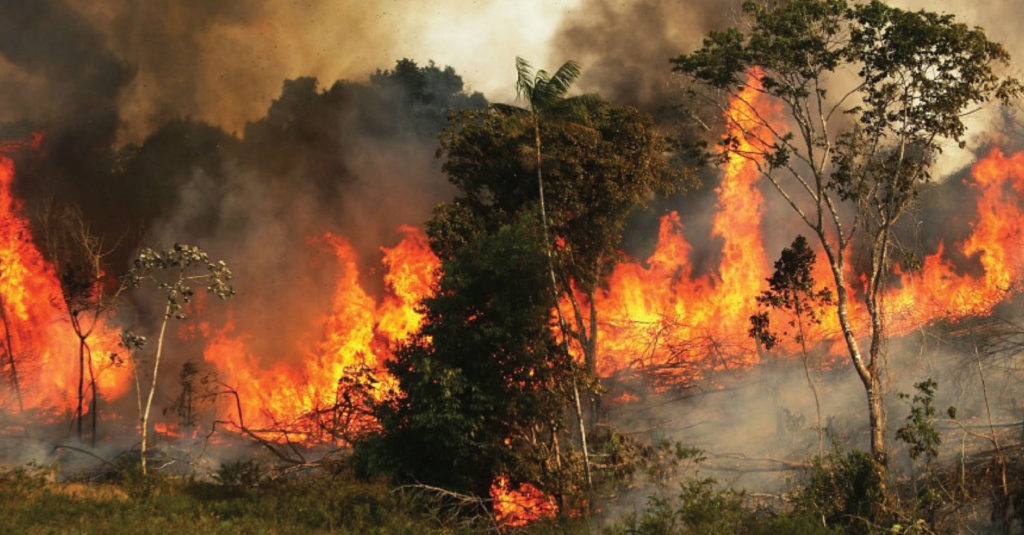
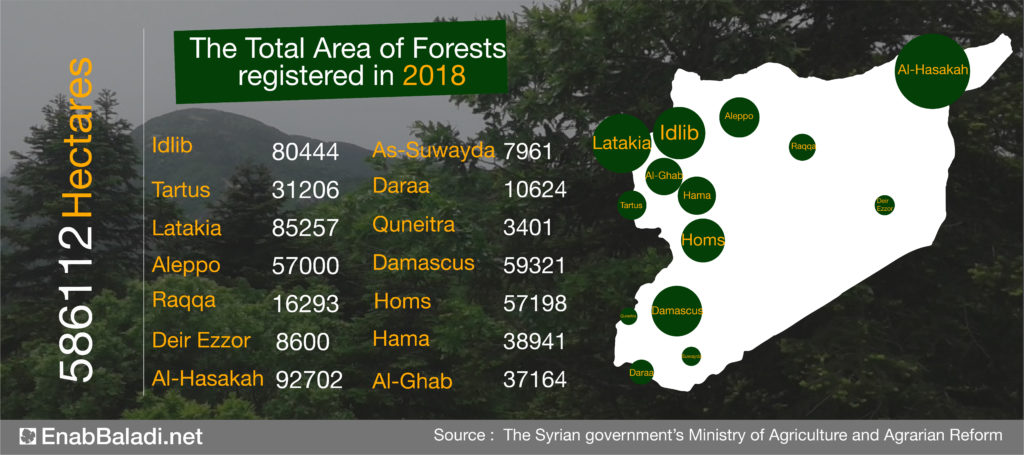
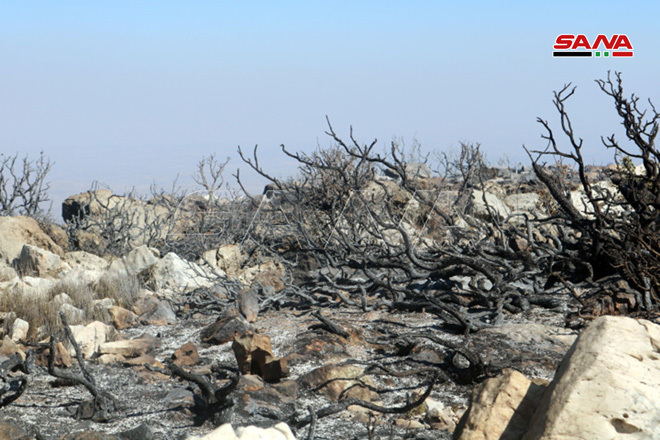
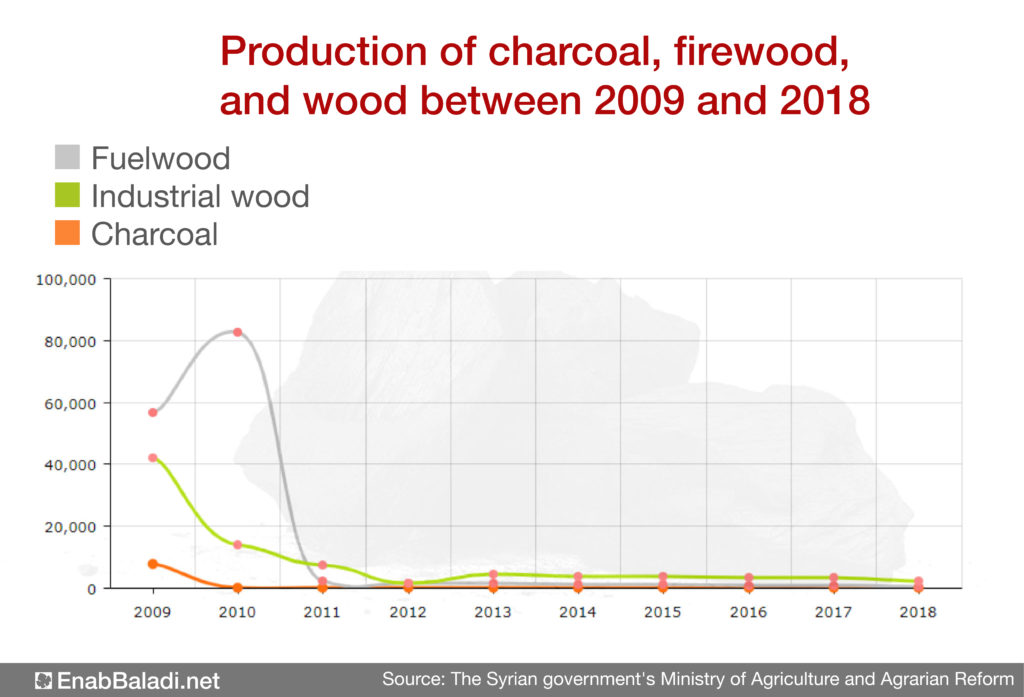






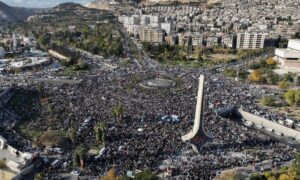
 More In-Depth
More In-Depth